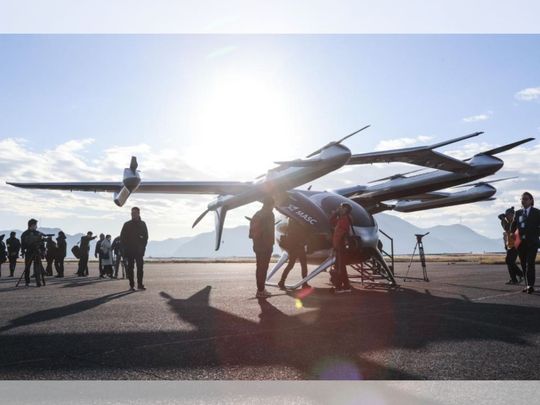
AutoFlight, an ambitious air taxi startup, has marked a groundbreaking milestone: its first successful eVTOL (electric vertical takeoff and landing) flight in Japan.
This isn't just a test flight—it's a bold declaration of intent in the fiercely competitive race to redefine transportation. AutoFlight is vying to secure certification from global aviation authorities, battling against industry heavyweights and trailblazing startups alike to become the ultimate "Uber of the skies."
This came after a demonstration flight in Japan made by Joby Aviation in tandem with its major investor Toyota in November.
AutoFlight’s vehicle, named the Prosperity, is a five-seater model weighing two tonnes and was delivered to an advanced air mobility (AAM) operator in Japan for the demonstration flight.

Air taxi industry taking off?
Numerous aviation start-ups and incumbents are racing to be certified by aviation authorities to operate eVTOL air taxi services in several cities.
The global air taxi industry is expected to post a 20 per cent annual growth from 2024, with a $14-billion total addressable market by 2032, thanks to advances in battery and propulsion technology, as per Global Market Insights.
The test flight, which took place in Okayama Prefecture, in partnership with the non-profit group MASC and under approval from the Japan Civil Aviation Bureau (JCAB), demonstrates its advancement and ability to expand its global reach.
Osaka World Expo 2025
Future test flights are planned in various Japanese cities to support the country’s vision of urban air mobility. This vehicle is also expected to showcase its capabilities during the 2025 Osaka World Expo.
AutoFlight has made significant strides globally as well.
The cargo version of the Prosperity, called CarryAll, recently became the first eVTOL over one tonne to receive type certification from the Civil Aviation Administration of China (CAAC).
This autonomous vehicle can carry up to two tonnes and operates fully independently.
From 3 hours to 20 minutes
In China, AutoFlight demonstrated the world’s first public inter-city eVTOL flight, cutting a three-hour car journey between Shenzhen and Zhuhai to just 20 minutes.
This flight marked a major milestone in the development of cross-sea, inter-city air taxi services.
The company is also exploring innovative applications for its technology, including a firefighting vehicle capable of carrying up to 800 pounds and extinguishing fires across large areas.
Test flights
Earlier versions of its flying vehicles have undergone extensive testing.
On May 8, 2024 a day after the EH-216S flew for the first time in the UAE, Autoflight’s larger 2-tonne class eVTOL V2000CG also flew for 41min and covered 123 km – with 44 per cent battery left when it landed.
This was followed by a dramatic formation flight of three full-scale models of its eVTOL aircraft on July 26. They flew for about 40 to 50 minutes, reaching a top airspeed of 230 km/h, and able to cover a range of up to 250km on a single charge.
Dual headquarters
AutoFlight, with dual headquarters in Shanghai and Germany, is supported by Team Global, a European technology group investing in cutting-edge eVTOL companies like Joby, Archer and Volocopter.
It operates a composite material manufacturing facility in Jining, Shandong Province, China, and a manufacturing center in Kunshan, China.
Additionally, AutoFlight runs an operation and test center in Napa County, California. Backed by the German investment group Team Global, AutoFlight aims to scale up safe and reliable solutions for urban air transportation and logistics.
AutoFlight’s products include logistics aircraft, autonomous passenger aerial vehicles, and the CarryAll cargo aircraft. The company has completed compliance tests for its CarryAll model, demonstrating its readiness for real-world deployment.
Air taxi rivalries
With each successful flight, the dream of zero-emission urban air travel edges closer to reality. But as the skies grow crowded with rivals, the stakes couldn’t be higher.
Can AutoFlight rise above the turbulence and claim its place in the annals of aviation history? Only time—and altitude—will tell.
• Increased range and payload capacity
Enhanced energy density in batteries directly translates to longer flight ranges and heavier payload capabilities. Companies like CATL are developing aviation-grade batteries with energy densities of 500 Wh/kg, enabling eVTOLs to achieve ranges of over 155 miles, as demonstrated by AutoFlight’s record-breaking Prosperity aircraft. These advancements could soon enable ranges up to 1,865 miles in larger electric aircraft, according to the Oak Ridge National Laboratory (ORNL).
• Cost, efficiency gains
Efficient battery systems reduce operational costs, as fewer charging cycles and less downtime are needed. The introduction of high-performance batteries tailored for eVTOL operations—capable of withstanding rapid discharge cycles during takeoff and hovering—improves energy utilisation.
• Enhanced safety and reliability
Advances in materials and control systems improve safety by minimising degradation under extreme conditions. Tailored battery chemistries, like those being explored at ORNL, enhance thermal stability and cycle life. These innovations reduce the risks associated with high-power applications, critical for public adoption and regulatory approval of urban air taxis.







_resources1_16a30b3fb8b_small.jpg)




